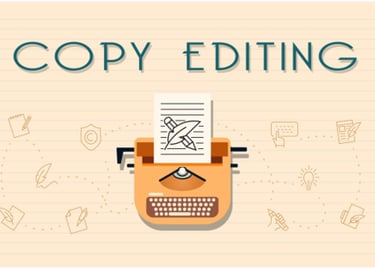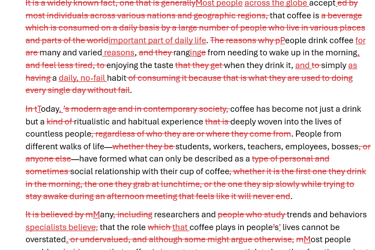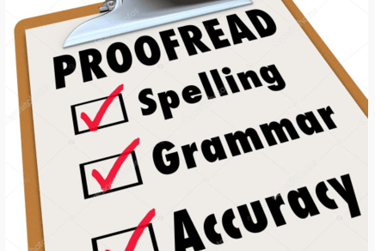What Kind of Editing Do You Need?
Different Types of Editing: What Sets Developmental Editing, Line Editing, Copy Editing, and Proofreading Apart [2025 Guide]
Developmental editing tackles the core foundation, like story flow and structure. Line editing shapes your writing's style, clarity, and tone. Copy editing checks for grammar, punctuation, consistency, and accuracy. Proofreading is the last step, catching any lingering mistakes before your work goes live.
Knowing how these editing steps differ helps clients choose what's needed for their work.
4 Main Types of Editing
Each editing type serving a specific role when preparing a manuscript for readers, and they work together for a polished final product.
# 1: Developmental Editing: Big Picture Changes
Developmental editing is the first and broadest pass in the editing process. It addresses high-level elements such as structure, flow, and core ideas. This stage is about more than grammar or spelling; it’s the blueprint phase that shapes the entire work.
At this stage, editors will look at:
Plot structure (for fiction) or argument logic (for nonfiction)
Clarity of message or theme
Character development or supporting evidence
Pacing and chapter organization
Typical deliverables include a marked-up manuscript with comments, an editorial letter summarizing feedback, and possible revision outlines. The goal is to strengthen the core of the manuscript before moving on to finer details.
# 2: Line Editing: Style and Language Enhancement
Line editing focuses on the way each sentence sounds and the style of the writing. It’s where a manuscript gains personality and clarity. Rather than rewriting the entire piece, line editing improves flow, word choice, and voice.
Key tasks include:
Tightening sentences for rhythm and readability
Adjusting word choices for clarity and impact
Consistency of tone and style
Removing wordiness or awkward phrasing
For example, a line edit might change “He walked slowly across the room” to “He shuffled across the room,” creating a sharper image. Line editors help the author’s unique voice shine through while making every word count.
# 3: Copy Editing: Technical Accuracy and Consistency
Copy editing brings technical precision. This stage polishes grammar, checks punctuation, and enforces style guides. It ensures the manuscript is free from factual blunders, spelling mistakes, and inconsistencies.
Copy editors focus on:
Grammar, punctuation, and spelling
Consistency in style and formatting
Adherence to chosen editorial standards (like AP, Chicago, or in-house guides)
Fact-checking names, dates, and key details
Unlike line editing, which shapes the feel of the writing, copy editing is about making sure every detail is correct and unified.
# 4: Proofreading: The Final Quality Check
Proofreading is the last inspection before publishing. At this stage, the focus shifts to surface errors that may have slipped through earlier edits. Proofreaders look for typos, formatting mishaps, and minor inconsistencies.
What gets checked:
Spelling, punctuation, and grammar errors
Consistent formatting (headers, margins, fonts)
Leftover mistakes from layout or design changes
This stage gives your project a final polish. Proofreading isn't intended to address big-picture or stylistic issues; it’s the last safety net before readers see the work.
Editing Tasks Can Overlap
In practice, these steps can overlap. It’s common for smaller projects, like articles or blog posts, to blend editing stages. An editor might make structural suggestions, tighten sentences, fix grammar, and check for typos in one go. For books or large projects, following each stage separately leads to a cleaner result. If you’re unsure where your writing stands, being clear on your needs and goals is key. so is hiring a flexible editor who can shine at any of these steps for you.
Knowing What You Need
Matching your project to the right editorial process sets you up for the strongest result. Ask for a free consult for advice!
Avoiding Common Mistakes
Writers often trip up by skipping steps or picking the wrong service. Keep these pitfalls in mind so you don’t waste time or money:
Hiring a proofreader when you really need big-picture help.
Asking for copy editing before the story or argument is fully developed.
Failing to ask for sample edits or references before hiring someone.
Rushing the process and expecting a fast turnaround for deep edits.
Not sure what level of editing you need?
I’ll help you clarify your manuscript’s stage and pick the right service. Start here.
Tips for Success With Your Editing Service
Name your manuscript’s current stage—be honest about how rough or polished it is.
Match your needs to the editing type—use the definitions of developmental, line, copy editing, and proofreading as a checklist.
Talk openly with your editor—share your needs, ask about their process, and confirm costs.
Avoid skipping steps—start with big-picture edits if your work isn’t yet solid, then move to details.
Look for editors with experience in your genre or field—relevant experience makes a difference.
Choosing wisely leads to smoother projects and stronger books—giving your readers the best possible experience with your words.
If you’re not sure what you need, connect with an experienced editor like me and discuss your manuscript’s stage.









Professional Editing Services
© 2025. All rights reserved.
Future Perfect Services, LLC
Dr. Susan J. Grant
Contact@FuturePerfectServices.com
Based in Maryland, USA
Serving clients globally
Clarity you can count on.
Not sure which service fits your needs?
I’d love to hear what you’re working on.
Lighthouse background by
Nathan Jennings via Unsplash
